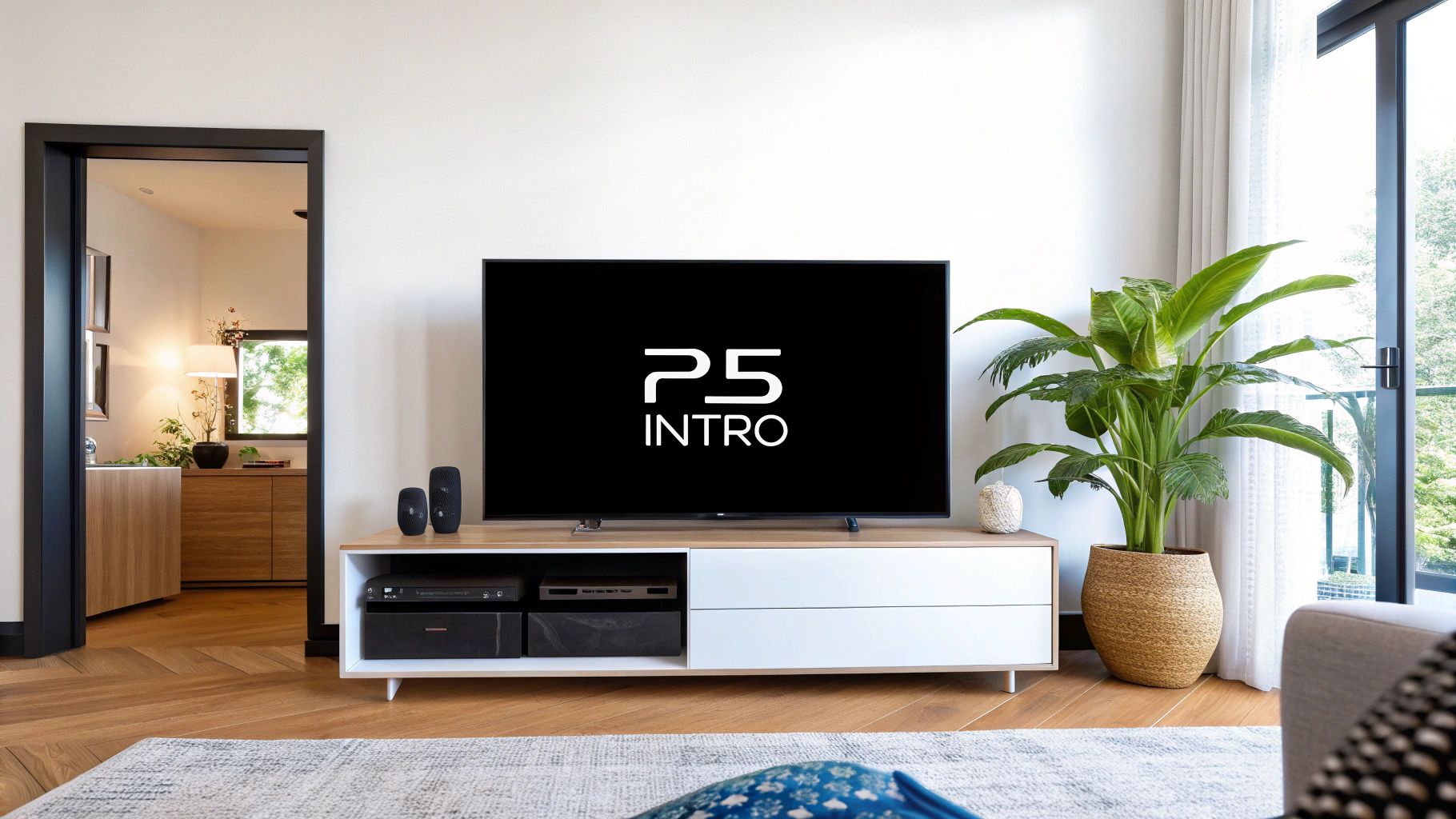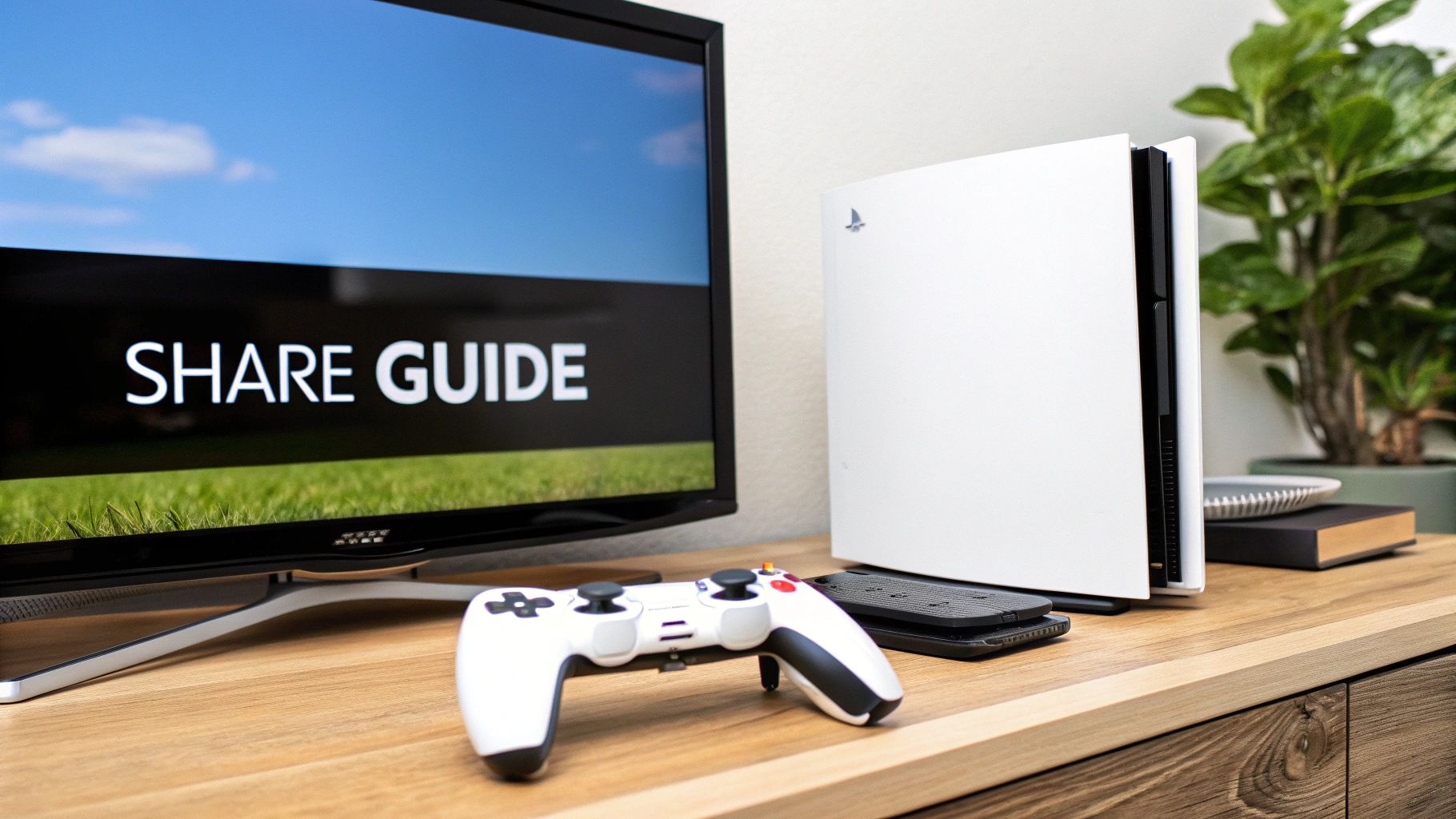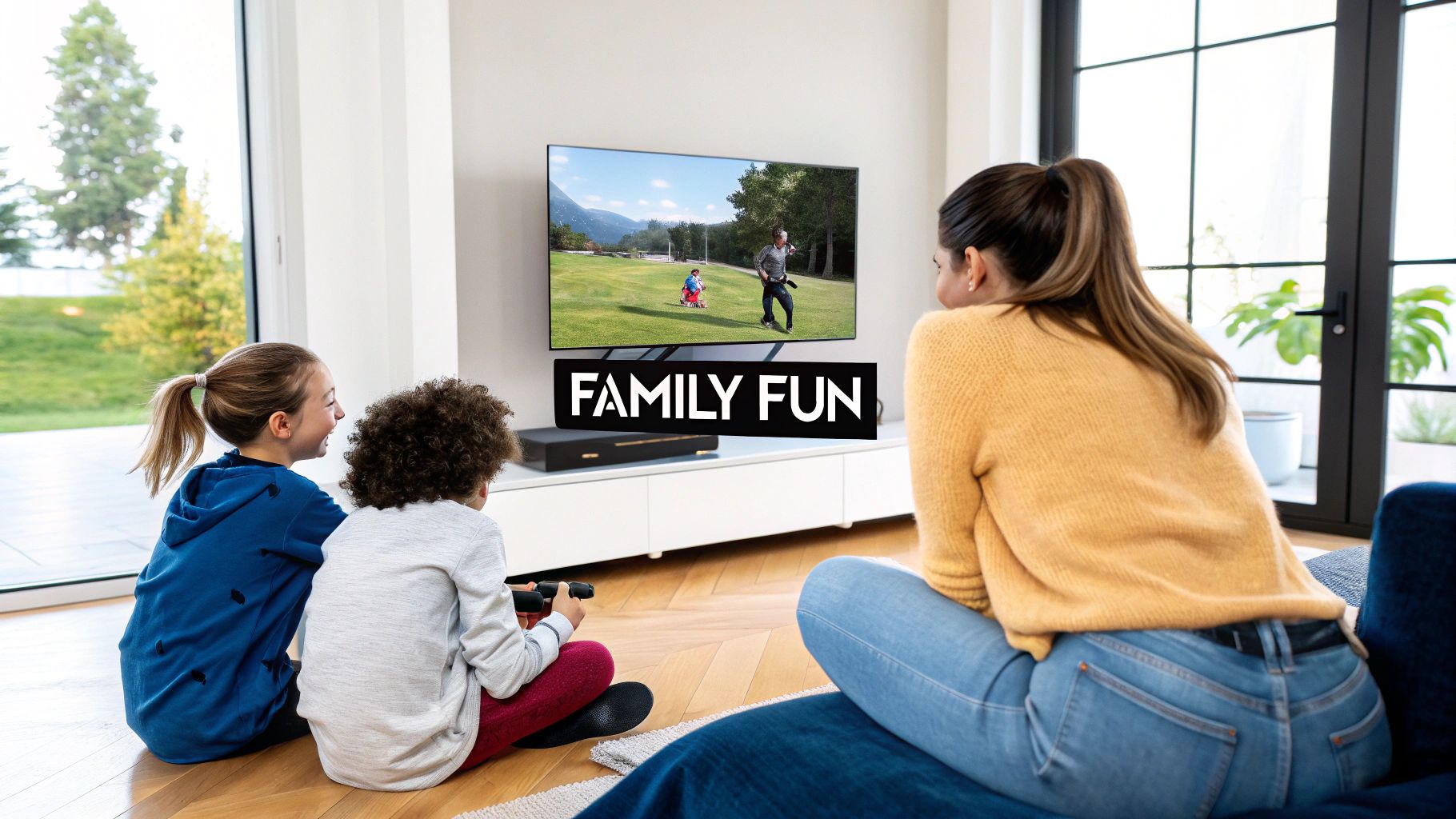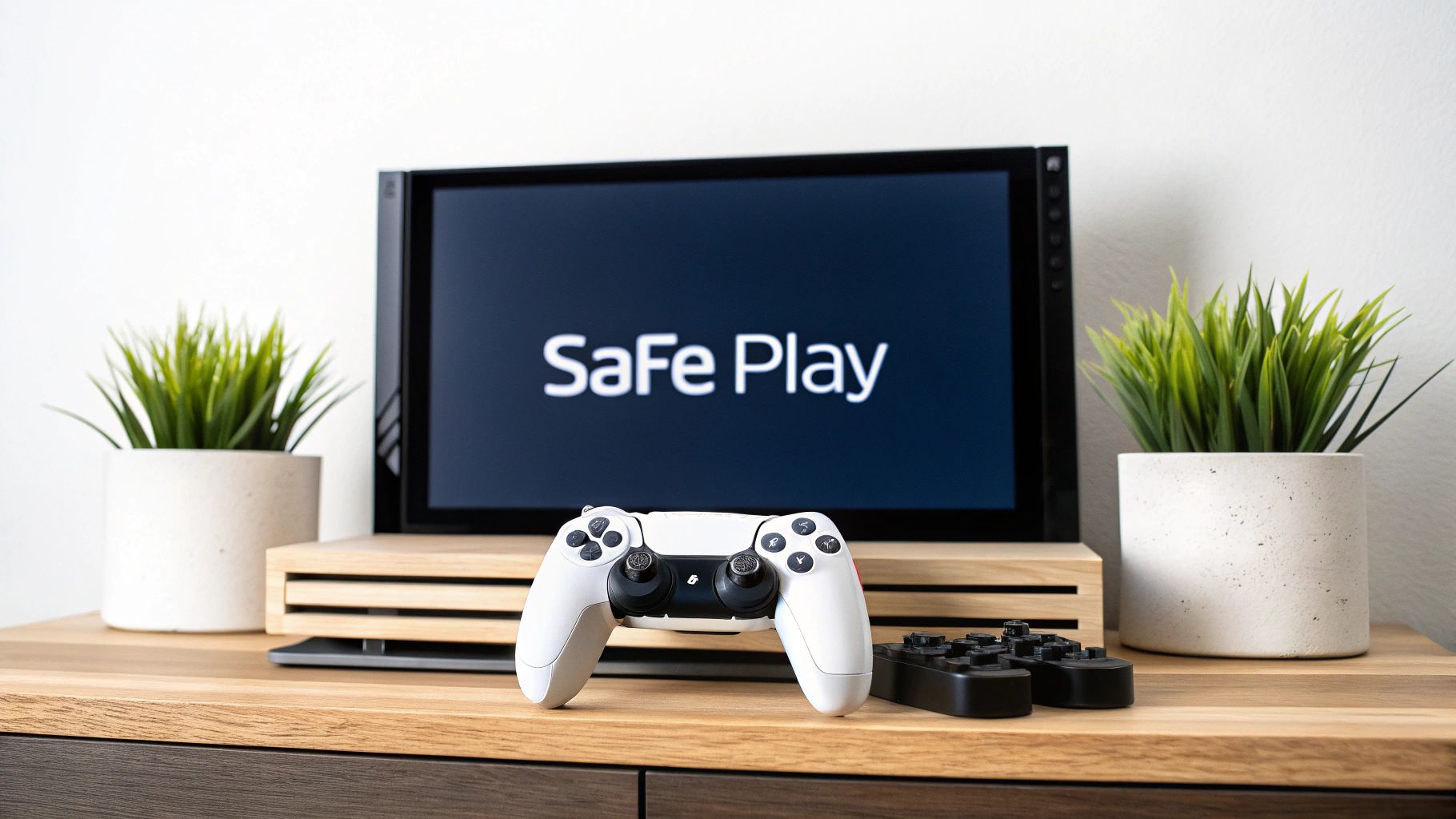
Get the Most Out of PS5 Console Sharing
Share
Understanding PS5 Console Sharing: Beyond The Basics

PS5 console sharing has changed how families and friends experience gaming. No longer is a separate copy of a digital game required for each player. This feature allows multiple users on one PS5 console to access and play games from a single game library. This offers a budget-friendly way to experience a broader range of games.
How Console Sharing Changes the Game
PS5 console sharing provides a more cost-effective way to play. Consider a family with two kids who want the latest game. Instead of buying two copies, they only need one. This dramatically reduces the cost, especially for families with multiple gamers. The shared access often extends to downloadable content (DLC) and other digital perks.
Console sharing can also build a stronger sense of community. Friends can share their libraries, discovering new games together. This shared experience encourages collaborative gameplay. It can also introduce players to genres they might not have considered before. This adds a social element, enriching the gaming experience.
Delving Deeper into PS5 Console Sharing Features
The PlayStation 5’s console sharing and offline play features give users more control over accessing their digital games. Users can share digitally purchased games across different accounts linked to the same console. This is particularly useful for families. For example, if one person buys a digital game, others on the same console can play it, even offline. For more information, check out this video: Discover more insights about PS5 Console Sharing.
Managing this feature is straightforward; it’s located within the PS5 settings under 'Users and Accounts' > 'Other' > 'Console Sharing and Offline Play'. Importantly, for added security, this setting can only be changed every six months.
The Benefits of Offline Play
Offline play guarantees continued game access, even without internet. This means uninterrupted gaming sessions, regardless of network issues. Imagine playing a game when the internet suddenly drops. With the PS5's offline play feature, you can keep playing. This uninterrupted access provides flexibility and convenience. Understanding these features is key to maximizing your PS5 experience.
Configuring PS5 Console Sharing: The Definitive Guide

Sharing digital games on your PlayStation 5 is easier than you think. This guide provides a clear path to setting up PS5 console sharing, allowing you and others to enjoy a wider range of games. We'll cover the key steps, highlight common issues, and offer helpful troubleshooting tips.
Understanding Primary and Secondary Accounts
The core of PS5 console sharing lies in the distinction between primary and secondary accounts. The primary account essentially designates the PS5 as its "home" console. This provides unrestricted access to all digital games purchased by that account. Other accounts on the console are considered secondary accounts. They can play the primary account’s games, even without owning them. This allows multiple users on one PS5 to enjoy a larger library of games.
Step-by-Step Setup Process
Setting up console sharing is straightforward. Follow these steps:
-
Sign in: Sign in to your PlayStation Network account on the PS5 console you want to designate as your primary.
-
Navigate to Settings: Go to "Settings," then "Users and Accounts," followed by "Other," and finally, "Console Sharing and Offline Play."
-
Enable Console Sharing: Select "Enable." Be mindful of the six-month limitation on changing this setting.
-
Verify: Double-check that the console is now recognized as your primary PS5.
-
Secondary Accounts: Other users can now sign in with their own accounts and access your shared games.
Before we dive into troubleshooting, let's look at a handy checklist to ensure proper setup.
The following table outlines the crucial steps for configuring console sharing, along with potential issues and how to address them.
PS5 Console Sharing Setup Checklist
| Setup Step | Required Action | Common Issues |
|---|---|---|
| Sign In | Sign in to your PlayStation Network account on the desired primary PS5. | Forgotten password, account locked. |
| Navigate to Settings | Go to Settings > Users and Accounts > Other > Console Sharing and Offline Play. | Difficulty navigating the menu. |
| Enable Console Sharing | Select "Enable." | Option grayed out, error message. |
| Verify Primary Console Status | Confirm the PS5 is recognized as the primary console. | Status not updated, incorrect console listed. |
| Secondary Account Access | Have secondary users sign in to their accounts. | Games not appearing for secondary users. |
This checklist provides a quick reference for each stage of the setup process. Refer to it if you encounter any difficulties during configuration.
Validating Your Setup
To ensure everything is working as expected, have a secondary account user try launching a game owned by the primary account. A successful launch confirms proper configuration. Test offline play by disconnecting the console from the internet. This verifies offline access to the shared games.
Troubleshooting Tips
Occasionally, shared games may not be accessible. Here are some troubleshooting tips:
-
Check internet connection: A stable internet connection is crucial for initial setup and accessing some features.
-
Verify primary console status: Ensure the PS5 is designated as the primary console for the game-sharing account.
-
Restore licenses: On the secondary account, navigate to "Settings" > "Users and Accounts" > "Other" > "Restore Licenses." This often resolves game access issues.
-
PlayStation Network status: Check the PlayStation Network status page for any outages or maintenance that might be affecting game access.
Managing Multiple PS5 Consoles
Even with multiple PS5 consoles in a household, console sharing offers advantages. The primary account holder can share games on one PS5, while others use their accounts on other consoles. Remember, each PlayStation Network account can only have one designated primary PS5.
Advanced Sharing Strategies
Strategic sharing of digital purchases can maximize your gaming library. Consider coordinating purchases among family members to access a wider selection of games. Furthermore, features like adaptive charging and personalized 3D audio enhance the PS5 gaming experience on all models, as highlighted in recent PlayStation blog posts. This comprehensive approach, from initial setup to troubleshooting and advanced strategies, allows you to fully utilize PS5 console sharing.
The Hidden Value of PS5 Console Sharing

PS5 console sharing offers much more than just access to a shared game library. It provides significant advantages, particularly for families and friends, changing how they buy and experience games. This feature unlocks a range of benefits that go beyond simple cost savings.
Significant Cost Savings for Families
One of the most apparent perks of PS5 console sharing is the potential for substantial cost savings. Consider a family with two gamers. Without console sharing, they would need two copies of every game. With this feature, only one purchase is necessary.
This drastically reduces the financial burden, especially for families who enjoy a wide variety of games. This benefit extends to downloadable content (DLC) as well, further stretching the value of every purchase.
Expanding Your Gaming Horizons
PS5 console sharing also opens the door to a wider range of gaming experiences. Friends can share their libraries, giving each other access to a whole new world of titles to explore. This can lead to discovering new favorites and genres that might have otherwise gone unnoticed. Sharing truly enriches the gaming experience.
Sharing Beyond Games
The advantages extend beyond the games themselves. PS5 console sharing also includes benefits like PlayStation Plus subscription features, providing access to online multiplayer and other perks. This added value makes a single subscription much more beneficial, as multiple users can enjoy the features. It creates a more connected and inclusive gaming environment.
Enhanced Social Gaming and Discovery
Console sharing can also greatly enhance social interaction between gamers. It creates more opportunities for friends and family to play together, even if they don't individually own the same games. This shared experience can foster a sense of community and friendly competition.
It can also lead to discovering new games through shared experiences and recommendations. The ability to share games through Console Sharing has been a key selling point for the PS5, attracting families and friends who want access to a larger library of digital titles.
As of December 2023, the PS5 boasts impressive sales figures, with over 50 million units sold. This makes it one of the fastest-selling consoles in history. This success speaks to the strong demand for features like Console Sharing, which adds significant value to digital game purchases. Explore this topic further
Unlocking the Full Potential of PS5 Console Sharing
By understanding the full scope of what PS5 console sharing offers, gamers can unlock its true value and elevate their gaming experience. It transforms gaming from a solitary pursuit to a shared activity, offering financial advantages and unique opportunities for exploration and connection. These benefits make PS5 console sharing a valuable feature for any gaming household or group of friends.
Navigating PS5 Console Sharing Boundaries & Restrictions

The PS5's console sharing feature offers a lot of advantages for gamers looking to share their digital libraries. However, it's important to understand the limitations involved to avoid any surprises. Knowing these boundaries beforehand can help ensure a smooth and frustration-free shared gaming experience. This section dives into the restrictions surrounding account access, playing games at the same time, and what content you can actually share.
Understanding Account Restrictions
PS5 console sharing lets the primary account holder share their digital games with others on the same console. There's a key restriction, though: only one primary console can be designated per PlayStation Network account. You can't have two different PS5 consoles simultaneously set as your primary to share your library across both. This is a fundamental limit to keep in mind.
Simultaneous Gameplay Rules
While secondary accounts can access and play the primary account's games, playing at the same time can get a little complicated. If the primary account holder is playing a game online, a secondary account on the same console might not be able to play that same title simultaneously. Good communication and coordination between users are essential to avoid conflicts.
Content Sharing Limitations
It's also worth noting that not all content is shareable. Digital games are generally shareable, but some things, like certain in-game purchases or subscriptions, may have their own licensing restrictions. For instance, a streaming service subscription tied to the primary account might not extend to secondary accounts.
Knowing these distinctions upfront helps manage expectations. Also, remember that physical games aren't part of this digital sharing system. Sharing those requires physically swapping the disc, and only the account owning the disc can play.
PlayStation Plus Membership Sharing Nuances
Sharing a PlayStation Plus membership has its own set of nuances. Secondary accounts on the primary PS5 can use the online multiplayer features, but perks like free monthly games or exclusive discounts are usually tied to the primary account holder. This clarifies the scope of PlayStation Plus sharing within a shared console setup.
Navigating the Six-Month Restriction
Changing your primary PS5 designation has a six-month limitation. This is designed to prevent people from constantly switching and potentially abusing the sharing system. This restriction could become an issue if you want to temporarily share your games with someone on another console, so plan your sharing arrangements carefully.
Maximizing Shared Gaming Options
Even with these limitations, there are ways to optimize console sharing. Open communication between users is crucial for managing game access and playtime. Coordinating game purchases and PlayStation Plus usage can also maximize the benefits for everyone involved. Console sharing on the PS5 reflects the broader digital rights management (DRM) landscape. DRM often restricts how content is shared. However, the PS5's approach with console sharing and offline play suggests a more consumer-friendly model, allowing more freedom in accessing purchased content. This is great for those with extensive digital libraries who want to share with friends or family without buying multiple copies. It also promotes a more collaborative gaming culture. Learn more about PS5 console sharing and offline play. By understanding and working within the existing boundaries, you can get the most out of the PS5 console sharing feature.
Resolving PS5 Console Sharing Issues Like A Pro
PS5 console sharing is a fantastic way to access a wider range of games without emptying your wallet. But occasionally, things can go wrong. This section explores common PS5 console sharing problems and offers practical solutions to get you gaming again quickly. We'll cover everything from authentication issues and network problems to those confusing error messages.
Common PS5 Console Sharing Errors and Solutions
Troubleshooting PS5 console sharing issues is often a matter of systematic investigation. Pinpointing the root of the problem is the first step towards fixing it. The following table offers a quick guide to diagnosing and resolving some frequent errors.
To help you quickly diagnose and address these issues, we've compiled a handy table summarizing common errors, their potential causes, and recommended solutions.
| Error Type | Possible Causes | Recommended Solutions |
|---|---|---|
| Can't Access Shared Games | Incorrect primary PS5 designation, Network connectivity issues, PlayStation Network outage | Verify primary PS5 status in settings, Check internet connection, Visit the PlayStation Network status page |
| Game Launches but Doesn't Play | Corrupted game data, License issues | Rebuild database in safe mode, Restore licenses on the affected account |
| Error Code (e.g., CE-108255-1) | Various, often related to specific games or system software | Consult the official PlayStation support website for error code details |
| Offline Play Not Working | Console sharing settings incorrect, Game doesn't support offline play | Verify console sharing and offline play are enabled, Check game documentation for offline play compatibility |
| Issues After System Update | Software conflicts, Corrupted data | Restart the console, Rebuild database in safe mode |
After reviewing the table, hopefully you've found a solution. If not, keep reading for more in-depth troubleshooting tips.
Troubleshooting Authentication Failures
One of the most common PS5 console sharing problems is authentication failure. This often happens when a secondary account tries to access a shared game but can't verify its access rights. This could be due to a few reasons. The primary account holder might have deactivated console sharing unintentionally, or there could be an issue with the PlayStation Network.
-
Check Console Sharing Status: Ensure your PS5 is designated as the primary console for the account sharing the games. Double-check this in the console settings under "Users and Accounts," then "Other," and finally, "Console Sharing and Offline Play."
-
Verify PlayStation Network Status: Check the PlayStation Network status page to make sure there are no service outages. Occasionally, a wider network problem can disrupt console sharing.
-
Restore Licenses: If the problem continues, try restoring licenses on the secondary account. This can resolve the issue by refreshing the account's access to downloaded content.
Resolving Mysterious Access Issues
Sometimes, even when PS5 console sharing is configured correctly, games can become inexplicably inaccessible. This can be particularly frustrating when everything seems to be set up properly. Here are some additional solutions:
-
Check Internet Connection: A stable internet connection is crucial for initial game access and authentication. Make sure your PS5 has a reliable connection.
-
Rebuild Database: If your internet connection isn't the problem, try rebuilding your console's database. This can often fix issues with corrupted data that might be interfering with game access. This process won't delete any games or save data.
-
Contact PlayStation Support: If you've tried everything else and are still having trouble, contacting PlayStation support may be necessary. They can provide more specific assistance.
Deciphering Confusing Error Messages
Sometimes, PS5 console sharing problems show up as cryptic error codes. While these codes can seem intimidating, they actually offer valuable clues for troubleshooting.
- Consult Official Resources: The official PlayStation support website is the best place to find out what those error codes mean. Each code relates to a specific problem, and the support site often suggests targeted fixes.
By understanding common PS5 console sharing problems and following these troubleshooting steps, you can quickly fix issues and get back to enjoying your shared game library. Staying updated with the latest PS5 system software can also help prevent future problems. Be sure to check out the official PlayStation Blog for updates.
Maximizing PS5 Console Sharing Offline Capabilities
PS5 console sharing offers more than just the ability to let friends and family play your games. It’s about providing access even when your internet connection is down. This is where offline play becomes essential, a key feature of PS5 console sharing that's often overlooked. Understanding how it works allows you to truly get the most out of your shared game library.
How Offline Play Works With PS5 Console Sharing
When internet outages strike, a properly configured PS5 console sharing setup is invaluable. The primary console designation lets secondary accounts access and play shared digital games without needing a constant online connection. For example, even if a storm disrupts your internet service, everyone can still play their favorite games offline.
Different Game Types and Offline Functionality
It's important to remember that not every game handles offline functionality the same way. Some single-player games offer a completely seamless offline experience. Others, especially those with online multiplayer components, might have limited functionality or be entirely unplayable offline. Knowing which games in your shared library fully support offline play is crucial for planning around potential internet disruptions.
Managing Save Data Across Shared Accounts
Managing save data is another vital aspect of offline play with PS5 console sharing. Ensure each user has their own profile on the console to prevent conflicts and overwritten save files. This keeps everyone's progress safe and separate.
Preparing For Planned Internet Interruptions
If you're expecting a scheduled internet outage for maintenance, there are steps you can take to maximize your offline gaming time. Pre-download any updates for your shared games. Also, double-check that the console is set as the primary PS5 for the account sharing the games. These simple preparations can prevent frustration during the downtime.
Maximizing Shared Content Accessibility Offline
For longer periods offline, consider using a dedicated external hard drive for shared games. This frees up space on the console's internal storage and creates a central hub for everyone's games. This makes them easily accessible even without an internet connection, especially beneficial for those with extensive shared libraries.
Offline Play and Digital Rights Management
Offline play with PS5 console sharing is part of a broader shift toward greater accessibility and convenience in gaming. The ability to share and play games offline has been widely appreciated for its practicality. Furthermore, PlayStation Plus subscribers enjoy additional benefits such as cloud storage for saved games. This enhances the overall gaming experience by securing game data online and offering a way to play offline even with unreliable internet service, making gaming more accessible in areas with inconsistent connectivity. Find more details about this feature here. These features highlight how sharing and offline play are increasingly important in the modern gaming landscape.
PS5 Console Sharing Evolution: What Veterans Need To Know
For seasoned PlayStation players, PS5 console sharing might seem like a familiar concept. However, understanding how game sharing has evolved since the PS3 era is vital for getting the most out of your digital game library and avoiding potential issues. This section explores the key differences between console generations, highlighting important changes and potential problems veterans should know.
From PS3 to PS5: Sharing Changes
PS3 game sharing relied heavily on physical discs and, later, digital downloads tied to a single PlayStation Network account. PS5 console sharing introduces the concept of a "primary console," allowing other accounts on that console access to digitally purchased games. This is a significant shift for veterans used to older methods.
Key Differences in How Sharing Works
A key difference is the shift away from physical media. While you can still share physical games by swapping discs, the focus now is on digital libraries and account management. On PS3, sharing meant lending a disc. On PS5, it's about granting digital access through your account.
Policy Changes and Their Effects
Sony's policies on digital ownership have changed over time. The PS5's primary console system offers more flexibility for sharing within a household. However, it also introduces restrictions, such as the six-month limitation on changing the primary PS5 designation. This could affect veterans used to more flexible sharing on older consoles.
Comparing Sharing Interfaces
The interface for managing shared content has been redesigned. The PS5 simplifies many processes. But navigating settings related to Users and Accounts, Console Sharing and Offline Play, and Rest Mode can initially confuse players familiar with the simpler PS3 interface.
Adapting Your Sharing Habits
Veterans need to adjust their sharing habits for the PS5. This includes understanding the difference between primary and secondary accounts, managing access to digital content, and troubleshooting occasional network issues. For example, while offline play is improved on the PS5, understanding the setup and individual game restrictions is essential for a smooth offline experience.
Accessing Older Shared Content
Switching to PS5 might raise questions about accessing games you shared previously. Digital games purchased on older consoles and linked to your account are generally accessible on PS5. But potential licensing issues might require troubleshooting. This highlights the importance of understanding license management within the PlayStation ecosystem.
Navigating the Generational Shift
Moving between console generations isn't always straightforward. Understanding Sony's current approach to digital ownership and navigating the new interfaces are important for veteran players. The PS5 offers better sharing features, including personalized 3D audio profiles and adaptive controller charging, as well as features added through system updates (see the PlayStation Blog for details). However, getting used to these new systems might take time.
Simplify Your Digital Life With AccountShare
Managing multiple subscriptions across various platforms can be challenging. AccountShare provides a way to securely and efficiently share premium accounts with trusted people. This can save you money and simplify access to numerous services, from streaming platforms to software. Visit AccountShare to learn more.
